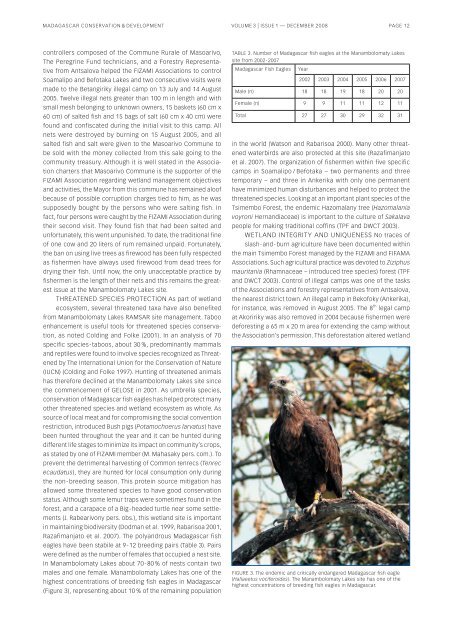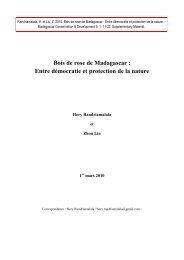Journal Madagascar Conservation - Madagascar Wildlife ...
Journal Madagascar Conservation - Madagascar Wildlife ...
Journal Madagascar Conservation - Madagascar Wildlife ...
Create successful ePaper yourself
Turn your PDF publications into a flip-book with our unique Google optimized e-Paper software.
MADAGASCAR CONSERVATION & DEVELOPMENT VOLUME 3 | ISSUE 1 — DECEMBER 2008 PAGE 12<br />
controllers composed of the Commune Rurale of Masoarivo,<br />
The Peregrine Fund technicians, and a Forestry Representative<br />
from Antsalova helped the FIZAMI Associations to control<br />
Soamalipo and Befotaka Lakes and two consecutive visits were<br />
made to the Betangiriky illegal camp on 13 July and 14 August<br />
2005. Twelve illegal nets greater than 100 m in length and with<br />
small mesh belonging to unknown owners, 15 baskets (60 cm x<br />
60 cm) of salted fish and 15 bags of salt (60 cm x 40 cm) were<br />
found and confiscated during the initial visit to this camp. All<br />
nets were destroyed by burning on 15 August 2005, and all<br />
salted fish and salt were given to the Masoarivo Commune to<br />
be sold with the money collected from this sale going to the<br />
community treasury. Although it is well stated in the Association<br />
charters that Masoarivo Commune is the supporter of the<br />
FIZAMI Association regarding wetland management objectives<br />
and activities, the Mayor from this commune has remained aloof<br />
because of possible corruption charges tied to him, as he was<br />
supposedly bought by the persons who were salting fish. In<br />
fact, four persons were caught by the FIZAMI Association during<br />
their second visit. They found fish that had been salted and<br />
unfortunately, this went unpunished. To date, the traditional fine<br />
of one cow and 20 liters of rum remained unpaid. Fortunately,<br />
the ban on using live trees as firewood has been fully respected<br />
as fishermen have always used firewood from dead trees for<br />
drying their fish. Until now, the only unacceptable practice by<br />
fishermen is the length of their nets and this remains the greatest<br />
issue at the Manambolomaty Lakes site.<br />
THREATENED SPECIES PROTECTION As part of wetland<br />
ecosystem, several threatened taxa have also benefited<br />
from Manambolomaty Lakes RAMSAR site management. Taboo<br />
enhancement is useful tools for threatened species conservation,<br />
as noted Colding and Folke (2001). In an analysis of 70<br />
specific species - taboos, about 30 %, predominantly mammals<br />
and reptiles were found to involve species recognized as Threatened<br />
by The International Union for the <strong>Conservation</strong> of Nature<br />
(IUCN) (Colding and Folke 1997). Hunting of threatened animals<br />
has therefore declined at the Manambolomaty Lakes site since<br />
the commencement of GELOSE in 2001. As umbrella species,<br />
conservation of <strong>Madagascar</strong> fish eagles has helped protect many<br />
other threatened species and wetland ecosystem as whole. As<br />
source of local meat and for compromising the social convention<br />
restriction, introduced Bush pigs (Potamochoerus larvatus) have<br />
been hunted throughout the year and it can be hunted during<br />
different life stages to minimize its impact on community’s crops,<br />
as stated by one of FIZAMI member (M. Mahasaky pers. com.). To<br />
prevent the detrimental harvesting of Common tenrecs (Tenrec<br />
ecaudatus), they are hunted for local consumption only during<br />
the non - breeding season. This protein source mitigation has<br />
allowed some threatened species to have good conservation<br />
status. Although some lemur traps were sometimes found in the<br />
forest, and a carapace of a Big - headed turtle near some settlements<br />
(J. Rabearivony pers. obs.), this wetland site is important<br />
in maintaining biodiversity (Dodman et al. 1999, Rabarisoa 2001,<br />
Razafimanjato et al. 2007). The polyandrous <strong>Madagascar</strong> fish<br />
eagles have been stabile at 9 - 12 breeding pairs (Table 3). Pairs<br />
were defined as the number of females that occupied a nest site.<br />
In Manambolomaty Lakes about 70 - 80 % of nests contain two<br />
males and one female. Manambolomaty Lakes has one of the<br />
highest concentrations of breeding fish eagles in <strong>Madagascar</strong><br />
(Figure 3), representing about 10 % of the remaining population<br />
TABLE 3. Number of <strong>Madagascar</strong> fish eagles at the Manambolomaty Lakes<br />
site from 2002 - 2007<br />
<strong>Madagascar</strong> Fish Eagles Year<br />
2002 2003 2004 2005 2006 2007<br />
Male (n) 18 18 19 18 20 20<br />
Female (n) 9 9 11 11 12 11<br />
Total 27 27 30 29 32 31<br />
in the world (Watson and Rabarisoa 2000). Many other threatened<br />
waterbirds are also protected at this site (Razafimanjato<br />
et al. 2007). The organization of fishermen within five specific<br />
camps in Soamalipo / Befotaka – two permanents and three<br />
temporary – and three in Ankerika with only one permanent<br />
have minimized human disturbances and helped to protect the<br />
threatened species. Looking at an important plant species of the<br />
Tsimembo Forest, the endemic Hazomalany tree (Hazomalania<br />
voyroni Hernandiaceae) is important to the culture of Sakalava<br />
people for making traditional coffins (TPF and DWCT 2003).<br />
WETLAND INTEGRITY AND UNIQUENESS No traces of<br />
slash - and - burn agriculture have been documented within<br />
the main Tsimembo Forest managed by the FIZAMI and FIFAMA<br />
Associations. Such agricultural practice was devoted to Ziziphus<br />
mauritania (Rhamnaceae – introduced tree species) forest (TPF<br />
and DWCT 2003). Control of illegal camps was one of the tasks<br />
of the Associations and forestry representatives from Antsalova,<br />
the nearest district town. An illegal camp in Bekofoky (Ankerika),<br />
for instance, was removed in August 2005. The 8 th legal camp<br />
at Akoririky was also removed in 2004 because fishermen were<br />
deforesting a 65 m x 20 m area for extending the camp without<br />
the Association’s permission. This deforestation altered wetland<br />
FIGURE 3. The endemic and critically endangered <strong>Madagascar</strong> fish eagle<br />
(Haliaeetus vociferoides). The Manambolomaty Lakes site has one of the<br />
highest concentrations of breeding fish eagles in <strong>Madagascar</strong>.



